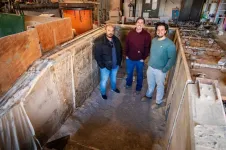(Press-News.org) University of Colorado Cancer Center member Sana Karam, MD, PhD, has received a translational research grant from the V Foundation for Cancer Research, co-founded by ESPN and legendary basketball coach Jim Valvano, to study a new therapeutic that may help pancreatic cancer patients overcome resistance to radiation therapy.
“Pancreatic cancer is deadly. The only treatment that can cure it is surgery to fully remove the tumor, but that is only an option when the cancer is caught early, which is rare,” Karam explains. “Radiation alone to shrink tumors before surgery has been tried, but with limited benefit. By studying patient and animal models, we discovered that while radiation can kill cancer cells and stimulate some good immune cells, it also can make the environment harsh, help cancer cells escape, and bring in some bad immune cells. It can also scar the tumor, making surgery harder.”
This project has earned Karam the Bob Bast Translational Research Grant, awarded to the V Foundation adult translational research project that received the highest ratings in 2023. Bob Bast, MD, chaired the V Foundation’s Scientific Advisory Committee for more than 20 years and continues to serve on the SAC and V Foundation board.
How STAT3 contributes
In her V Foundation-funded study, Karam plans to further study the role of a molecule called STAT3 that enables the negative effects of radiation. In a previous research project, Karam and her team found that blocking STAT3 preserved the benefits of radiation therapy while hindering the undesired consequences. In her new study, Karam will test a pill patients can take, while undergoing radiation, that blocks STAT3.
>> For more information on the clinical trial, visit the CU Anschutz Medical Campus' clinical trials page.
“In liver cancer, this drug was quite effective, and the FDA has prioritized it for trials,” Karam says. “This is the first time it will be combined with radiation to treat pancreatic cancer in humans. We will collect blood and tissue from pancreatic cancer patients before and after the pill-and-radiation treatment and study how this combination affects the tumor and the patient’s immune system. We also hope to develop a test that predicts patient response to combination of radiation and the STAT3 blocker and to identify other ways the cancer cells might be escaping.”
Patient benefits
A successful trial, Karam says, would mean reduced morbidity and mortality for pancreatic cancer patients, making surgery a possibility, especially less complicated surgery to remove tumors that have been successfully reduced in size by radiation.
“I anticipate good outcomes, based on what we’ve seen and how this drug is performing in cancers that are similar to pancreatic cancer,” she says. “But even for those who may not respond, understanding the biology around response and resistance will be highly significant for developing future therapies. The current 10% five-year survival rate for this cancer is not acceptable.”
A long road
Karam’s research into radiation resistance in pancreatic cancer has been a yearslong journey, and she emphasizes that it’s not one she has taken alone. CU Cancer Center Director Richard Schulick, MD, MBA, and CU Cancer Center member, Marco Del Chiaro, MD, clinical director of the hepato-pancreato-biliary program in the CU Department of Surgery, and the entire medical oncology team, have been with her every step of the way, she says, and she is grateful for their support.
She is also grateful to the V Foundation, as well as Wings of Hope, for the funding that may have lifesaving results for future pancreatic cancer patients.
“It’s an incredible honor to be recognized by people who are so passionate about cancer research,” she says. “It’s funded by patients, by families, by those who have walked that journey. I take that as a badge of honor, and I will make sure that we live up to that name.”
END
V Foundation grant enables research on radiation resistance in pancreatic cancer treatment
2024-01-09
ELSE PRESS RELEASES FROM THIS DATE:
The role of fibronectin in BRAF-mutant thyroid cancer treatment
2024-01-09
New research overseen by University of Colorado Cancer Center member Rebecca Schweppe, PhD, could lead to improved treatment for people with thyroid cancer characterized by a mutation in the BRAF gene — a mutation also responsible for some types of melanoma, colorectal cancer, leukemia, lymphoma, and ovarian cancer.
“The BRAF mutation is a common mutation in thyroid cancer,” Schweppe says. “It has a high prevalence of mutations in two different subtypes — papillary thyroid cancer, or PTC, and anaplastic thyroid cancer, or ATC — and there's a lot of interest in targeting this pathway. Other tumor types, like melanoma ...
Current research on prevalence of prolonged grief disorder is inadequate
2024-01-09
Waltham — January 8, 2024 — Proper procedures for diagnosing prolonged grief disorder (PGD) are not being followed in research into its prevalence, according to a study published in Harvard Review of Psychiatry, part of the Lippincott portfolio from Wolters Kluwer. What’s more, most published literature doesn’t clearly acknowledge the limitations of the methodology used.
The lead investigator was Margaret S. Stroebe, PhD, a clinical psychologist at Utrecht University and the University of Groningen ...
New NIH-funded center could soon reduce the need for pharmaceutical trials on animals
2024-01-09
The University of Rochester will house a new national center focused on using tissue-on-chip technology to develop drugs more rapidly and reduce the need for animal trials. The National Institutes of Health awarded a $7.5 million grant to establish the Translational Center for Barrier Microphysiological Systems (TraCe-bMPS) at Rochester in partnership with Duke University.
The center aims to develop five Food and Drug Administration–qualified drug development tools related to ...
Police leaders face challenges when seeking to accommodate community stakeholders
2024-01-09
Police reform movements often focus on improving police-public relationships. These ties are a focus of community policing and procedural justice, two significant reform efforts in policing worldwide over the last three decades. In a new article, researchers examine issues involved in these efforts, especially limitations to communication, and highlight implications for police-community relations.
The article, by researchers at Arizona State University (ASU) and the University of California, Santa Barbara (UCSB), is published in Psychology, Public Policy, and the Law.
“Reform movements that try to improve relationships ...
New book provides roadmap for police management of public order
2024-01-09
Managing public order at large demonstrations, protests, and assemblies is a demanding and necessary task. A new book provides an international review of public order management experiences and effective practices. Through practical examples grounded in multidisciplinary theory and science, the book offers a roadmap to improve police response and increase safety at large gatherings in democratic countries.
The book, Public Order Policing: A Professional's Guide to International Theories, Case Studies, and Best Practices, was edited by researchers at the University of Nevada, Las Vegas (UNLV); ...
Department of Energy announces $24 million for small business research and development grants
2024-01-09
Washington, D.C. – The U.S. Department of Energy (DOE) today announced awards totaling $24 million for small businesses in 30 states and the District of Columbia. The 111 projects funded by DOE’s Office of Science include the development of computing, advanced materials, and scientific instrumentation that will help advance the department’s clean energy mission.
“Small businesses are the cornerstone of America and contribute significantly to the growth of our economy,” said Asmeret Asefaw Berhe, ...
Transatlantic project works to fortify coastal resilience against rising seas
2024-01-09
Climate change is leading to an increase in sea level rise, putting millions of people in danger of severe coastal flooding in coming years.
Sherif Abdelaziz, associate professor in the Charles E. Via, Jr. Department of Civil and Environmental Engineering at Virginia Tech, is collaborating with researchers from Heriot-Watt University in Edinburgh, Scotland, to find solutions to keep coastal areas safe by enhancing the resilience of sea walls against increasing coastal flooding. The PIONEER project is funded by the Engineering and Physical Sciences Research Council and is aiming to be the initial step in a global collaboration to strengthen coastal ...
A Jupiter-sized planet has been hiding a big secret: A 350,000-mile-long tail
2024-01-09
Key takeaways
Astrophysicists have found that a large exoplanet known as WASP-69b is being trailed by a tail of gas seven times as long as the planet itself.
The comet-like tail is the result of the planet’s gas atmosphere being burned off as it passes precariously close to the hot star it orbits and stretched by stellar winds.
By studying this process in real time, scientists can better understand how thousands of other planets in our galaxy have evolved.
WASP-69b is having a hot girl summer that never ends. The huge gaseous exoplanet, roughly the size of Jupiter and approximately ...
How black silicon, a prized material used in solar cells, gets its dark, rough edge
2024-01-09
Researchers at the U.S. Department of Energy’s Princeton Plasma Physics Laboratory (PPPL) have developed a new theoretical model explaining one way to make black silicon, an important material used in solar cells, light sensors, antibacterial surfaces and many other applications.
Black silicon is made when the surface of regular silicon is etched to produce tiny nanoscale pits on the surface. These pits change the color of the silicon from gray to black and, critically, trap more light, an essential feature of efficient solar cells.
While there are many ways to make black silicon, including some that use the ...
The secret to better rural healthcare: Pay doctors to travel from urban to rural areas
2024-01-09
Researchers from University of Oxford, Arizona State University, and University of Iowa published a new Journal of Marketing study that examines how paying doctors to visit rural areas is a cost-effective way to provide reasonable access and effective care to most rural communities.
The study, forthcoming in the Journal of Marketing, is titled “Bringing the Doctor to the Patients: Cardiology Outreach to Rural Areas” and is authored by J. Jason Bell, Sanghak Lee, and Thomas S. Gruca.
Rural health care is in crisis.
Between 2010 and 2015, the death rate from coronary heart disease was significantly ...


